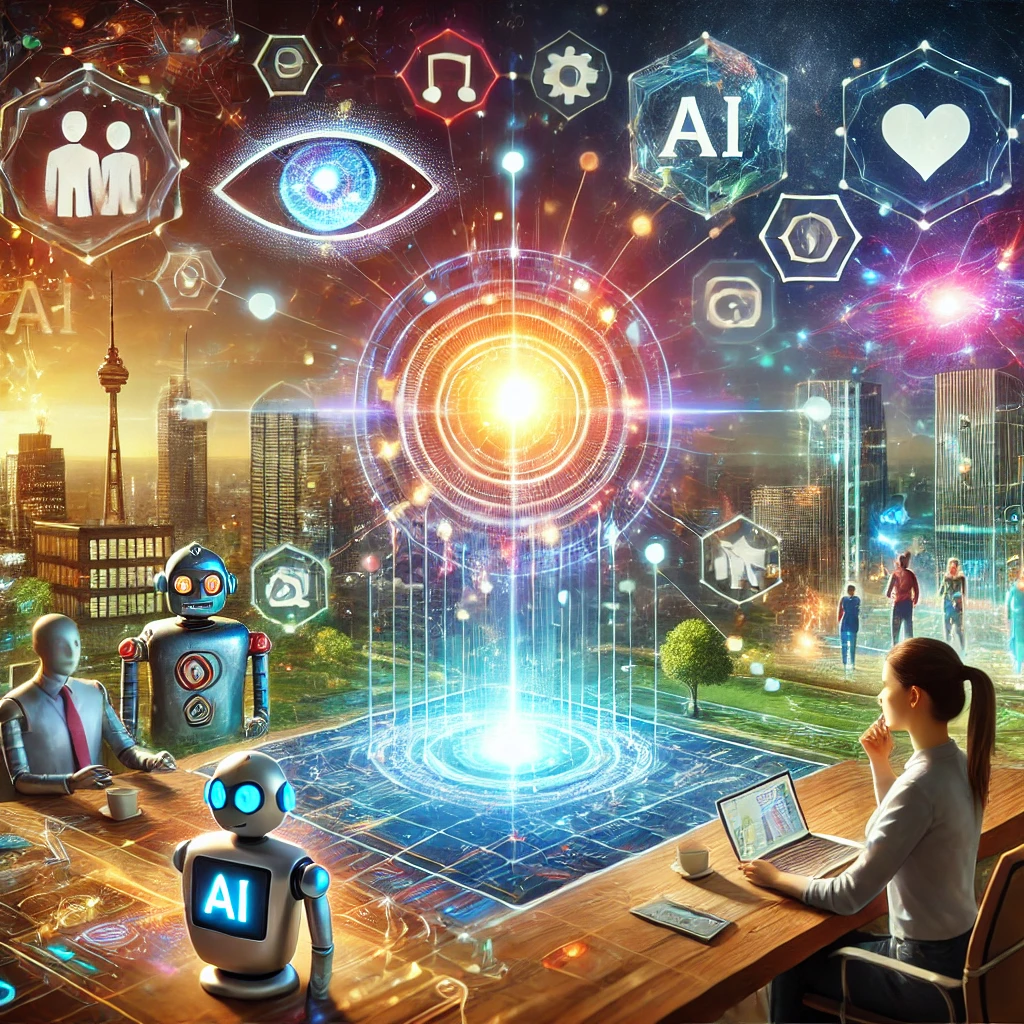As technology evolves, the integration of artificial intelligence (AI) and augmented reality (AR) is transforming the way we interact with digital and physical worlds. Augmented reality enhances our environment by overlaying digital content on the real world, while AI brings intelligence and adaptability to these experiences, making them more immersive and interactive. From gaming and retail to education and healthcare, AI-driven AR is expanding the boundaries of what is possible, delivering tailored experiences that feel intuitive and engaging. This article explores how AI is enhancing AR technology and the various applications of this powerful combination.
The Role of AI in Augmented Reality
Augmented reality uses sensors, cameras, and displays to project digital information into the physical world. However, AI takes this a step further by adding intelligence to AR applications, allowing them to understand and react to user behavior, environment, and context. AI algorithms can process vast amounts of data in real time, allowing AR systems to identify objects, recognize faces, track movements, and even interpret emotions. This level of responsiveness enables AR applications to feel natural, making the user experience more seamless and realistic.
AI-driven AR systems utilize machine learning, computer vision, and natural language processing to interpret and analyze the surrounding environment. For example, computer vision techniques enable AR applications to identify objects or landmarks, enhancing AR navigation experiences. Natural language processing allows voice-activated AR systems to respond to spoken commands, providing hands-free interactions in settings like remote support and virtual training. As AI technology advances, these capabilities will become even more sophisticated, allowing AR applications to deliver personalized, contextually relevant information in real time.
Applications of AI-Enhanced AR in Various Industries
The combination of AI and AR is having a profound impact across multiple industries, each utilizing these technologies to enhance user engagement, streamline workflows, and provide new ways of learning and interacting. Here are some key applications:
1. Gaming and Entertainment
The gaming industry has been a pioneer in using AR to create immersive experiences. With the addition of AI, gaming experiences become more interactive and responsive. For instance, AI-powered NPCs (non-playable characters) in AR games can react to player actions, learn from past interactions, and adapt their behavior accordingly, making gameplay more dynamic. AI can also create personalized gaming experiences by adapting difficulty levels or suggesting in-game objectives based on the player’s skill level and preferences.
Beyond gaming, the entertainment industry is exploring AI-enhanced AR for live events and experiences. Imagine attending a concert where AI-driven AR projects real-time visual effects that sync with the music, or visiting a theme park where interactive AR characters respond to guest interactions, creating a more engaging experience. These AI-driven interactions create a unique blend of digital and physical worlds, offering experiences that feel both magical and memorable.
2. Retail and E-Commerce
In the retail sector, AI-driven AR is transforming the way customers shop by offering personalized, interactive experiences. AI-powered AR apps allow customers to “try on” products virtually, such as clothing, accessories, or makeup, before making a purchase. For example, AI-enhanced AR mirrors in stores can analyze facial features, skin tone, or body shape to suggest products that suit the individual’s preferences and appearance.
AI-driven product recommendations add another layer of personalization, as the AR system learns from user preferences and browsing history. For instance, an AR shopping app can suggest similar items or complementary products, helping users discover products they might not have considered otherwise. This level of personalization not only enhances the shopping experience but also increases customer satisfaction and boosts sales.
3. Education and Training
AI-enhanced AR is revolutionizing education by creating immersive learning environments that cater to individual learning styles and paces. For example, AI-powered AR applications in science classes can project 3D models of molecules, planets, or historical events, allowing students to interact with complex concepts in an engaging, hands-on way. The AR system, driven by AI, can adapt the content based on the student’s progress, providing hints, feedback, or additional resources when needed.
In professional training, AI-enhanced AR provides realistic simulations that help workers practice and refine their skills in a safe environment. Medical students, for example, can use AR to simulate surgeries, while AI provides feedback on their technique, precision, and timing. In fields like construction or manufacturing, AR headsets with AI can guide workers step-by-step through complex assembly or repair tasks, reducing errors and improving efficiency.
4. Healthcare
AI-powered AR is making a significant impact in healthcare by assisting doctors in diagnosis, treatment planning, and patient education. In surgeries, AR headsets can overlay a patient’s medical data, such as MRI scans or X-rays, onto the surgeon’s view, providing real-time guidance during complex procedures. AI enhances this process by analyzing the data and highlighting key areas of concern, such as a tumor or a critical blood vessel.
AR is also being used in patient care and rehabilitation. For example, AI-driven AR applications can guide patients through physical therapy exercises, providing feedback on their form and progress. Additionally, AR can be used to help patients understand their medical conditions, as doctors use AI-powered visualizations to explain diagnoses or treatment plans, fostering better communication and patient engagement.
5. Remote Assistance and Collaboration
AR combined with AI is revolutionizing remote assistance by allowing experts to provide guidance in real time. In industrial settings, technicians can wear AR glasses that display overlays of machine components, while AI identifies the parts and suggests repair steps. This level of support reduces downtime and improves accuracy, as workers can troubleshoot complex machinery with AI-enhanced guidance from remote experts.
AI-powered AR is also valuable in collaborative work environments, enabling teams to interact with 3D models and visualizations. For example, architects and engineers can use AR to review building designs with colleagues in different locations. AI-driven tools can help analyze structural integrity or suggest design improvements, enhancing collaboration and speeding up decision-making.
The Future of AI-Enhanced Augmented Reality
The future of AI-enhanced AR is promising, with continuous advancements in AI, machine learning, and hardware technology. We can expect more intuitive, immersive, and adaptable experiences that cater to individual preferences and needs. Innovations in AI, such as improved object recognition, emotion detection, and natural language processing, will make AR applications smarter and more context-aware. This will allow AR systems to provide even more accurate, personalized responses and facilitate deeper, more meaningful interactions.
Moreover, advancements in wearable AR devices will make these technologies more accessible and convenient, allowing individuals to seamlessly integrate AR into their daily lives. Imagine a future where AI-driven AR assistants help you with tasks ranging from cooking recipes and exercise routines to navigation and social interactions.
Conclusion
The combination of AI and augmented reality is reshaping how we experience the world around us, bringing immersive, interactive, and personalized experiences to life. From gaming and retail to education and healthcare, AI-enhanced AR is transforming industries and enriching user experiences in unprecedented ways. As AI and AR technologies continue to evolve, the potential for creating meaningful, real-time interactions between the digital and physical worlds will only grow. By harnessing the power of AI-driven AR, we can look forward to a future where technology adapts to us, making our everyday interactions more engaging, efficient, and enjoyable.



OMG! This article is AMAZING! AI + AR = The future is NOW!
Lmao, 10 months later and still nothin happened 😅
I wish I had an AI trainer for my workouts, it would be way less boring!
Great article! The integration of AI and AR is game-changing. The future of technology is exciting!
AI & AR together?! 🤯 Reality, but BETTER! Games, shopping, education… the possibilities! ✨ Future is wild!
wow itts really amazyng what this hard technology really collaborate 👍👍
ai +ar is sick 👍👍 so futuristic n fun!👍👍
a years passed n ppl just talkin bout it 🥱